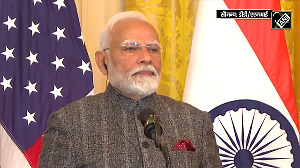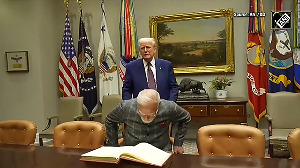Negotiations on agricultural issues at the World Trade Organisation continues to be stalled over the conversion of specific or non-ad valorem agricultural tariffs into ad valorem equivalents. While the US and Australia are on board, the European Union is yet to agree.
A crucial meeting of the five interested parties -- the US, the EU, Australia, India and Brazil -- was held yesterday at Sao Paulo. Though India did not directly participate in the discussion, it was a listening member. Brazil was also represented by an official.
India and the WTO: News and Issues
"The main issue now is to convince the EU. We hope that Australia and US will be able to bring EU on board," a senior government official told Business Standard.
The FIPs meeting precedes an important meeting of senior level officials in Geneva in mid-April where all the issues in agriculture, non-agriculture market access and services will be taken up.
Earlier this month, talks had broken down at Geneva on the question of ad-valorem equivalents.
Developing countries want developed countries, which have a high percentage of their tariffs in the form of specific duties, to provide the relevant data so that the duties can be converted into ad-valorem, a more transparent duty structure.
Ad-valorem duty is expressed as a percentage of the value of the imported item, while the non ad-valorem duty is fixed as a specific duty levied per unit of currency, or compound duties, or mixed duties which is a mix of ad-valorem and specific or as "other" formulations, including technical factors such as percentage of agricultural component such as sugar, alcohol, milk, etc.
India has only two items, pertaining to almonds that are under specific rates. The US has 42.5 per cent of its tariff lines under non ad-valorem, while the EU has nearly 46 per cent.
As per the Consolidated Tariff Schedules Database, nearly 7,977 agricultural tariff lines are bound in non ad-valorem terms by 34 members, counting the European Commission and Switzerland-Liechtenstein as one. These tariff lines account for over 20 per cent of all the final bound agricultural tariff lines.
Officials said conversion of tariffs to ad-valorem is the first step in pushing for tariff reduction. "Irrespective of what formula is used by the developing countries, the ad-valorem rates of both the developing and developed world will have to converge.
There cannot be a huge difference. Since the average ad-valorem tariffs of developing countries is low, the developed countries will have to bring their ad-valorem rates in line," an official said.
State of play
-
WTO negotiations are deadlocked over agricultural taxes. Here's why
-
The developing countries want the developed world to convert their specific tariffs to ad valorem
-
The five interested parties -- the US, the EU, Australia, India and Brazil -- met at Sao Paulo, but the talks failed
-
India has only two items under specific rates, while the US has 42.5 per cent of its tariff lines and the EU 46 per cent
-
Conversion of tariffs to ad-valorem is the first step in pushing for tariff reduction
- US and Australia are on board, the EU is yet to agree







 © 2025
© 2025